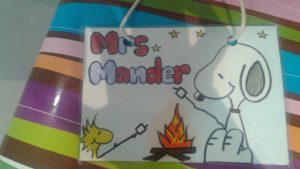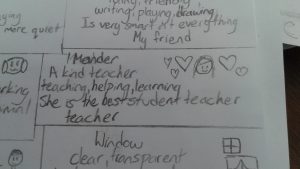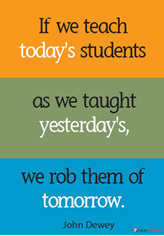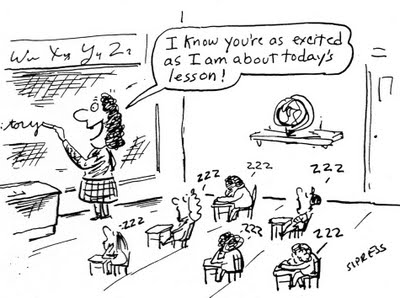 Another 4 weeks have passed and I have learned so much! With each passing day, I become more comfortable and learn how to support the various learning styles of my students. I have learned to use this knowledge to adapt my lesson plans and ensure that I integrate the different learning styles within the classroom. In my lessons, I include as many visuals as possible (videos, pictures, charts) as the majority of students in my class are visual learners. Any time they are working on a fun project or assignment, they often ask me to create one too! For instance, we went on a 2 day camping trip and students created name tags. They wanted me to make one too, so I did!
Another 4 weeks have passed and I have learned so much! With each passing day, I become more comfortable and learn how to support the various learning styles of my students. I have learned to use this knowledge to adapt my lesson plans and ensure that I integrate the different learning styles within the classroom. In my lessons, I include as many visuals as possible (videos, pictures, charts) as the majority of students in my class are visual learners. Any time they are working on a fun project or assignment, they often ask me to create one too! For instance, we went on a 2 day camping trip and students created name tags. They wanted me to make one too, so I did!  We are also creating French pizza menus and I was told that I have to make one too!
We are also creating French pizza menus and I was told that I have to make one too!
I have been incorporating as many hands-on activities as possible into my lessons so that students will remember what they have learned. In one of my recent lessons where I taught students about the angles in a triangle, I set up an activity in which the students discovered on their own that the angles always add up to 180°. This worked so well that I decided to do the same thing for quadrilaterals. They were very excited about figuring out angles on their own. Just yesterday, one of my students said to me, “I like your lessons because you always have a fun activity for us to do”. Hearing a comment like this is the best feeling in the world. It showed me that the students are enjoying learning, which is our ultimate goal as educators.

Prior to beginning the poetry unit, I was anxious because students had made comments about how much they dislike poetry. Now, they grab their booklets whenever they have free time so that they can work on their poems. We started off simple with Haikus and Cinquains and in the next few weeks, we will write free verse and limericks, which they are very excited about!
One thing that I have realized is that you can’t plan too much in advance. I have always been a “planner”, thinking ahead about the next few weeks. One day, I began to look ahead at the next two weeks and write down notes about my lessons. However, we ended up having a few assemblies, some fire/earthquake drills, and other disruptions that are to be expected in schools. I had put a lot of time into creating the schedule and this was when I understood the true meaning of being flexible!
Overall, everything is going very smoothly and along with the students, I am learning so much and definitely enjoying this valuable experience.

 This past week has been just as fun. The students are learning about forces and motion and we have watched videos, played tug-of-war, and conducted experiments to test how different factors affect force. I have noticed that these hands-on activities keep all of the students, especially the quieter ones, engaged and having fun. During lessons, students work individually but they also work in pairs or larger groups. I have found that groups of 3-4 work very well in my class but it is crucial that I create the groups beforehand as it allows for me to ensure the groups are balanced in terms of their personalities and abilities. It is also important to change the groups and mix the students up. The first time that I created groups of 4, the students worked extremely well together so I decided to use the same groups for an activity the following week because I was so happy with their teamwork and collaboration. However, many times during recess and lunch, students would approach me and ask me to put them in groups with their friends. Now they know that when they show progress while working with their friends, it is possible that they may be in a group together in the near future.
This past week has been just as fun. The students are learning about forces and motion and we have watched videos, played tug-of-war, and conducted experiments to test how different factors affect force. I have noticed that these hands-on activities keep all of the students, especially the quieter ones, engaged and having fun. During lessons, students work individually but they also work in pairs or larger groups. I have found that groups of 3-4 work very well in my class but it is crucial that I create the groups beforehand as it allows for me to ensure the groups are balanced in terms of their personalities and abilities. It is also important to change the groups and mix the students up. The first time that I created groups of 4, the students worked extremely well together so I decided to use the same groups for an activity the following week because I was so happy with their teamwork and collaboration. However, many times during recess and lunch, students would approach me and ask me to put them in groups with their friends. Now they know that when they show progress while working with their friends, it is possible that they may be in a group together in the near future.
 Students want to:
Students want to:


 her great resource by Mary Kim Schreck is her book titled You’ve Got to Reach Them to Teach Them: Hard Facts About the Soft Skills of Student Engagement. Some of the main topics covered in this book include the importance of relationships, emotions, and environment. Establishing healthy relationships is key to achieving student success. Schreck discusses various ways as to how teachers can help students bring out their best. By doing so, this will ultimately create a positive environment in the classroom. By allowing them to make mistakes, take risks, and feel confident, students will be able to immerse themselves in their learning. This book makes strong connections to real-life situations and is relevant due to its inclusion of journal entries and comments directly from students. Schreck uses scientific research to prove her claims and discusses various strategies that can be implemented in the classroom to increase student engagement and academic achievement.
her great resource by Mary Kim Schreck is her book titled You’ve Got to Reach Them to Teach Them: Hard Facts About the Soft Skills of Student Engagement. Some of the main topics covered in this book include the importance of relationships, emotions, and environment. Establishing healthy relationships is key to achieving student success. Schreck discusses various ways as to how teachers can help students bring out their best. By doing so, this will ultimately create a positive environment in the classroom. By allowing them to make mistakes, take risks, and feel confident, students will be able to immerse themselves in their learning. This book makes strong connections to real-life situations and is relevant due to its inclusion of journal entries and comments directly from students. Schreck uses scientific research to prove her claims and discusses various strategies that can be implemented in the classroom to increase student engagement and academic achievement.

 From Tired to Inspired by Mary Kim Schreck teaches strategies to engage students in literacy. However, as with some of my other resources, the strategies in this book can also be transferred across various subject areas. Schreck describes the importance of improving the quality of “talk” in the classroom. There needs to be a change in who is doing the talking and how it is structured. Teachers need to encourage an inquiry-based approach to learning and move away from interrogations. Conversations are a high-quality opportunity for deeper learning and teachers needs to provide opportunities for students to question, converse, and be active listeners. In accordance with 21st century learning, teachers need to move away from the front of the room, both figuratively and literally. However, when teachers are providing instruction, responding with something as simple as “yes, and…” as opposed to “yes, but…” to a student’s response can go a long way. If educators can teach students through rehearsals (i.e: possible methods of solving problems), modeling (i.e: there can be more than one right answer), and role-playing activities, students can become active learners and use class discussions effectively to engage with the learning material.
From Tired to Inspired by Mary Kim Schreck teaches strategies to engage students in literacy. However, as with some of my other resources, the strategies in this book can also be transferred across various subject areas. Schreck describes the importance of improving the quality of “talk” in the classroom. There needs to be a change in who is doing the talking and how it is structured. Teachers need to encourage an inquiry-based approach to learning and move away from interrogations. Conversations are a high-quality opportunity for deeper learning and teachers needs to provide opportunities for students to question, converse, and be active listeners. In accordance with 21st century learning, teachers need to move away from the front of the room, both figuratively and literally. However, when teachers are providing instruction, responding with something as simple as “yes, and…” as opposed to “yes, but…” to a student’s response can go a long way. If educators can teach students through rehearsals (i.e: possible methods of solving problems), modeling (i.e: there can be more than one right answer), and role-playing activities, students can become active learners and use class discussions effectively to engage with the learning material.

